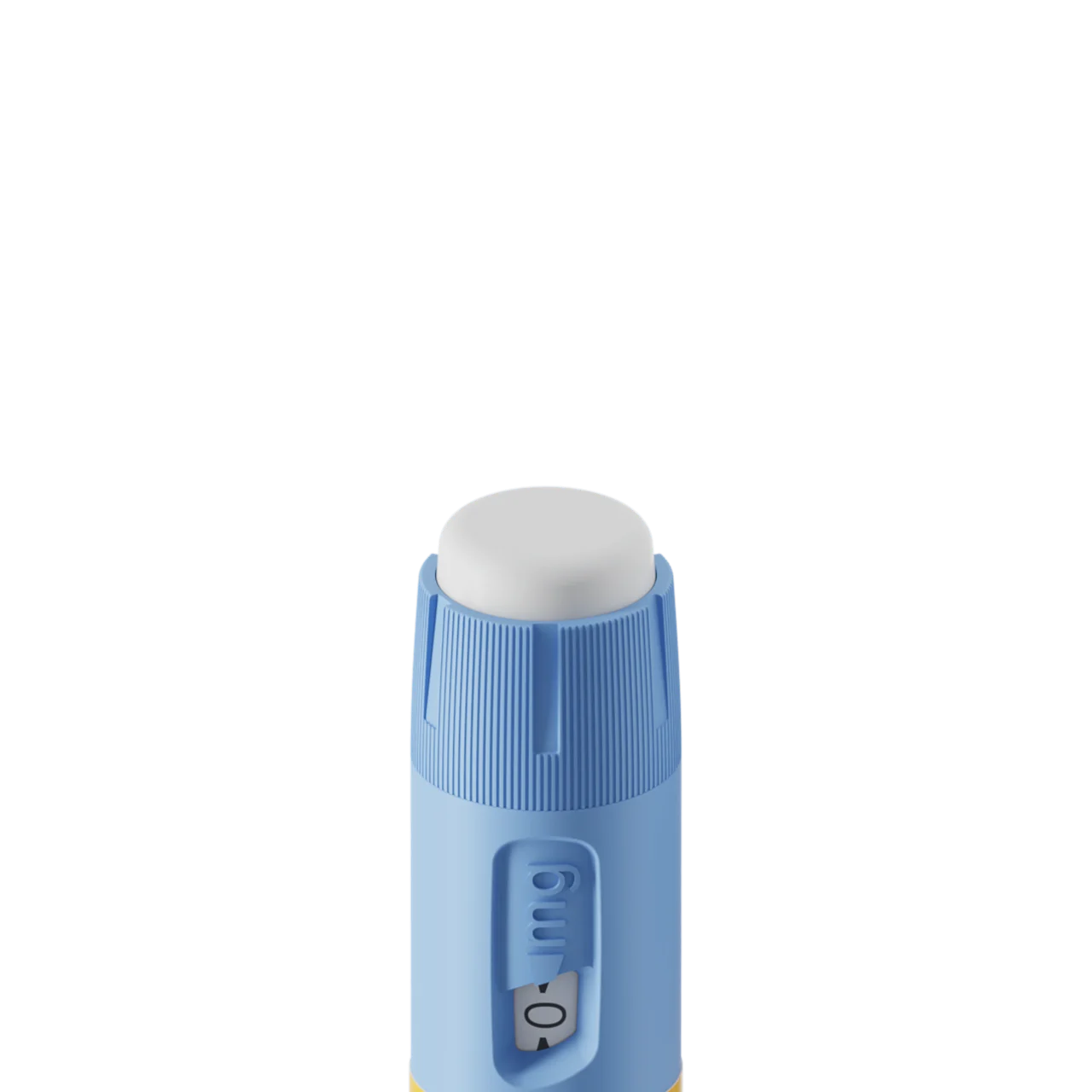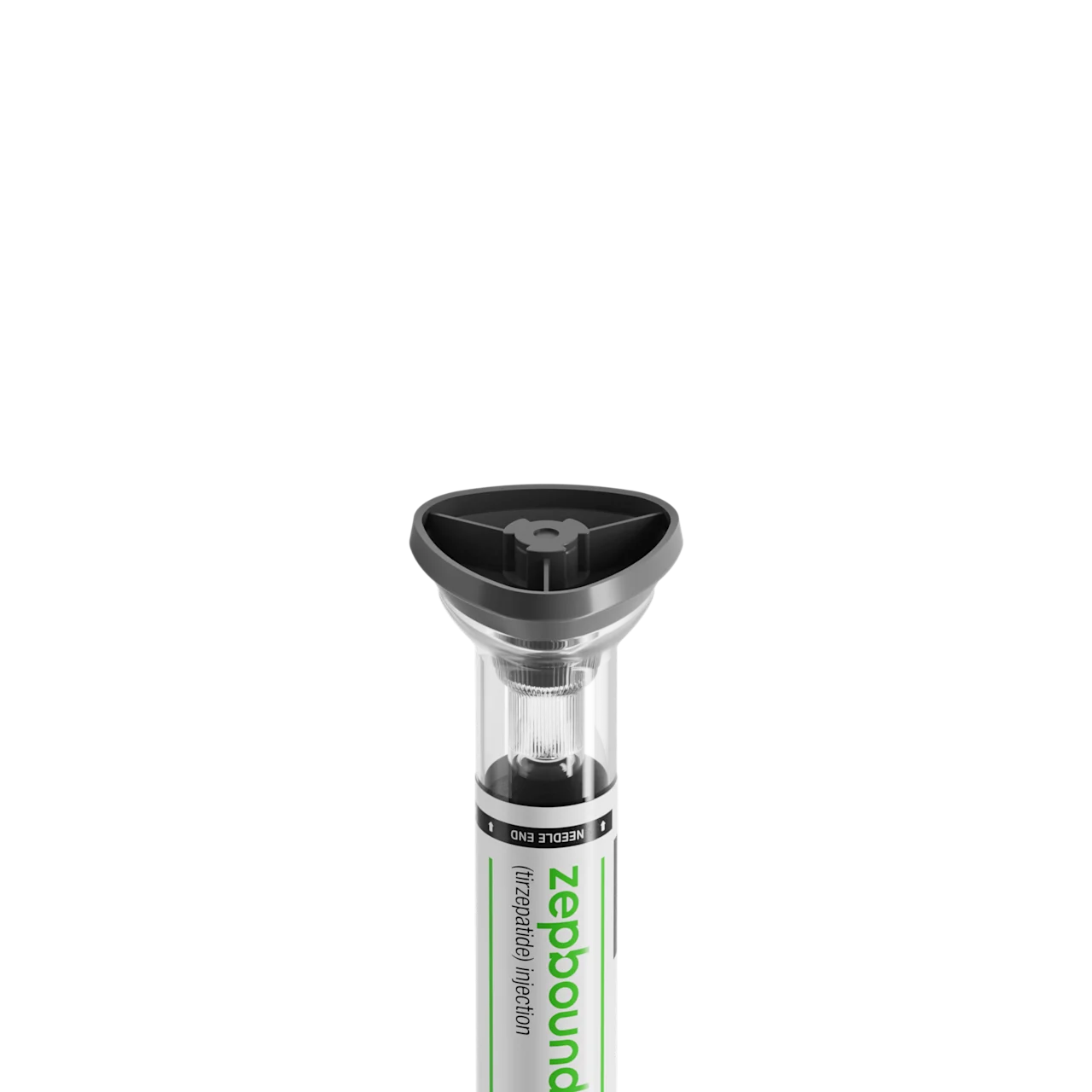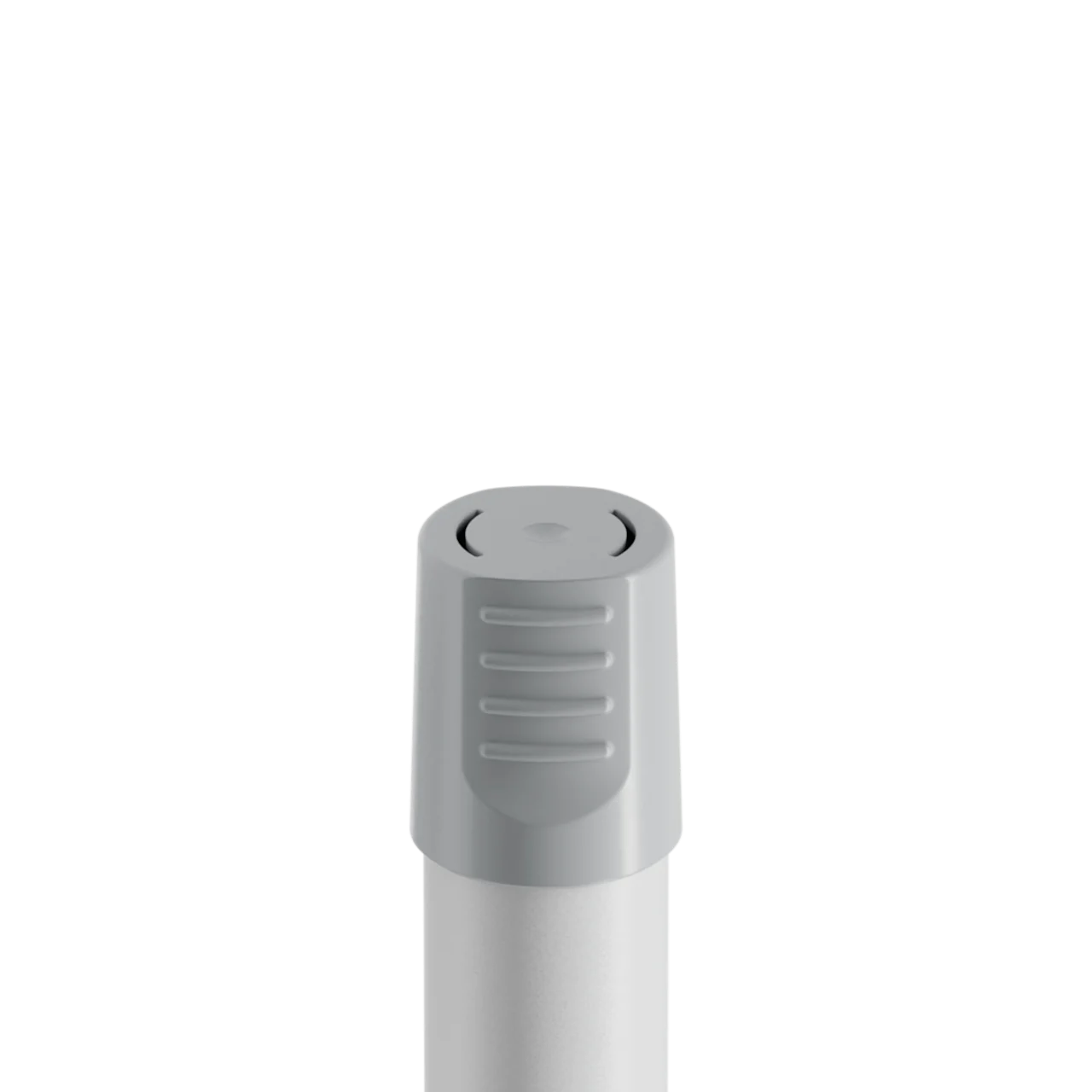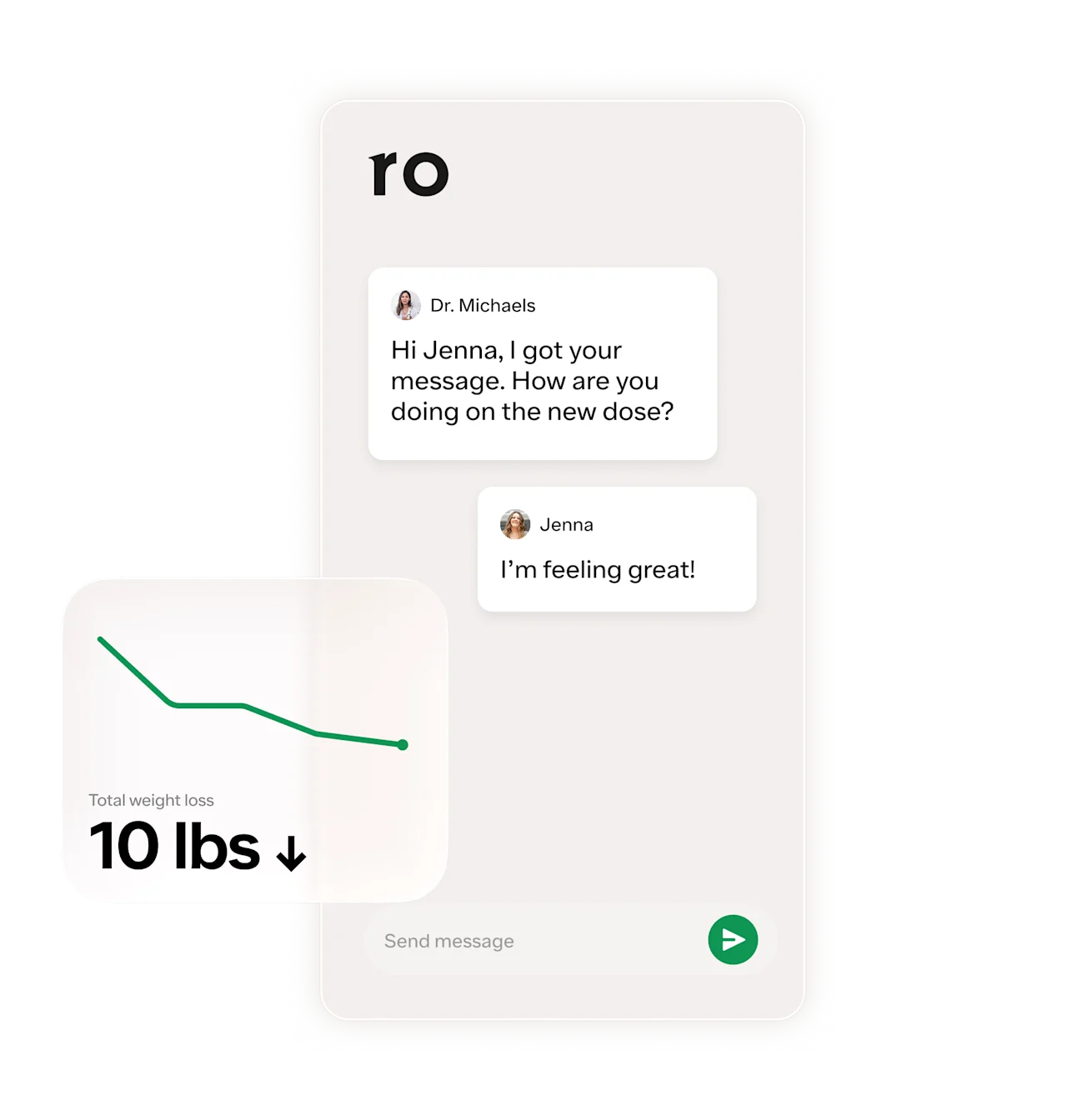Key takeaways
You may be losing inches but not weight if you’re gaining muscle, losing body fat, or experiencing shifts in water retention or hormone levels.
The scale doesn’t always tell the full story. Your body composition and overall health often reveal more about your progress.
Pay attention to how your clothes fit, your energy levels, and your strength to get a clearer, more meaningful picture than numbers alone.
If you’re not sure why the scale isn’t moving, a healthcare provider can help you assess your goals and explore options like lifestyle changes or weight-loss medications.
Here's what we'll cover
Here's what we'll cover
Here's what we'll cover
Key takeaways
You may be losing inches but not weight if you’re gaining muscle, losing body fat, or experiencing shifts in water retention or hormone levels.
The scale doesn’t always tell the full story. Your body composition and overall health often reveal more about your progress.
Pay attention to how your clothes fit, your energy levels, and your strength to get a clearer, more meaningful picture than numbers alone.
If you’re not sure why the scale isn’t moving, a healthcare provider can help you assess your goals and explore options like lifestyle changes or weight-loss medications.
If you’ve been working out or eating differently and notice your clothes fit better but the scale hasn’t budged, it can be confusing. Many people wonder why they’re losing inches but not weight, noticing their waist, hips, or thighs shrinking even when the number on the scale stays the same.
It can feel confusing or even discouraging, especially if you’re putting in the effort to lose weight. But in many cases, losing inches but not weight is actually a good sign — it means your body composition is changing in ways that go beyond what the scale can capture.
Here’s why you might be losing inches but not weight, what it means for your progress, and how to keep track of the weight loss results that really matter.
Why am I losing inches but not weight?
You may be losing inches but not weight because your body composition is changing, which isn’t always accurately reflected in the number on the scale. Common reasons for losing inches but not weight include:
Gaining lean muscle while losing fat
Hitting a temporary weight loss plateau
Retaining water from diet, exercise, hormones, or other factors
Below, we’ll unpack how each of these can affect your progress (and what it means for your goals).
1. You’re losing body fat but gaining muscle
This is one of the most common reasons people lose inches without seeing a big difference in weight, and it’s actually a good thing. Muscle is denser than fat — meaning it takes up less space per pound — so as you build muscle and lose fat, your body can look smaller and more toned even if your overall weight hasn’t changed much.
If you’ve recently started strength training, this is especially likely. Studies show that resistance training helps increase muscle mass while reducing fat mass, even when total body weight remains the same. These shifts in body composition are linked to better metabolic health, strength, and long-term weight management.
You may also notice improvements in posture, endurance, and how your clothes fit. These are all signs your body is becoming leaner and stronger, even if the scale doesn’t move.
2. You’ve hit a plateau
If you’ve been following the same workout or eating plan for a while, you might’ve hit a plateau, which is the point where your body adapts to your current routine. Plateaus are common during weight loss because as you lose fat or muscle, your metabolism can slow down a bit, meaning you burn fewer calories at rest.
This doesn’t always mean your progress has stopped altogether. Sometimes, small recompositions are still happening beneath the surface (like losing inches but not weight) as your body adjusts.
The good news is that most plateaus are temporary and can be overcome with small adjustments to your routine or nutrition.
3. You’re dealing with water weight
Water weight can fluctuate from day to day and temporarily mask fat loss on the scale, and that’s completely normal. Common causes of water retention include:
High sodium intake: Eating salty foods can cause your body to hold onto extra water.
Hormonal changes: Menstrual cycle phases and hormonal shifts, including those during pregnancy, can temporarily increase water retention.
Inflammation: Intense exercise, an illness, or even a minor injury can trigger an inflammatory response that causes tissues to retain fluid as part of healing. This temporary swelling usually subsides as inflammation decreases.
Carbohydrate intake: Stored carbs (glycogen) bind to water molecules, so changing your carb intake can cause temporary weight fluctuations.
In these situations, the scale might stay steady even as you lose fat and inches. Eating a balanced diet, reducing excess sodium, and even adequate protein intake can help minimize short-term changes in fluid balance.
Benefits of losing inches
Losing inches, even without losing weight, can signal meaningful changes in your body composition and overall health. Here are a few benefits to keep in mind:
Improved body composition: Losing inches without changes on the scale often means you’re reducing body fat and gaining or maintaining lean muscle. This shift can improve your metabolism, strength, and long-term health outcomes.
Better metabolic health: Even modest fat loss around the waist can improve blood pressure, cholesterol, and insulin sensitivity — all key factors in preventing metabolic conditions like type 2 diabetes.
Increased confidence and comfort: Clothes fitting better, improved posture, and more visible muscle tone can all boost confidence and make daily movement feel easier and more comfortable.
Enhanced physical performance: As you lose inches and gain muscle, you may notice improvements in endurance and strength. These are all signs your workouts are paying off in ways the scale can’t measure.
Better long-term results: Focusing on body composition rather than weight alone can lead to more sustainable progress, since building muscle helps maintain weight loss and prevent weight regain over time.
What to do if you’re losing inches but not weight?
Losing inches but not weight can actually be a good sign. It often means you’re gaining lean muscle and improving your body composition, even if the number on the scale isn’t changing. Still, if you’re not seeing the progress you expect, there are a few things you can do to better understand what’s happening and keep moving toward your goals.
Below, find tailored tips depending on what’s likely causing your results.
1. If you’re gaining muscle
Building muscle while losing fat can make your weight stay steady, but it’s a positive sign of progress. You’re getting stronger, boosting your metabolism, and supporting long-term health, even if the scale doesn’t reflect it yet.
Try this:
Track strength, not just weight: Note your progress in the gym. Are you lifting heavier weights or completing more reps? That’s a clear indicator your body is adapting to the work you’re putting in.
Reassess your goals: Instead of aiming for a certain number on the scale, consider goals related to strength, endurance, or how your clothes fit.
Focus on consistency: Research shows that regular resistance training (2–3 times per week) paired with adequate protein intake can help maintain lean muscle while reducing fat mass.
2. If you’ve hit a plateau
Plateaus are a common part of a weight loss journey. Your body naturally adapts to changes in exercise and diet over time, which can slow down or stall progress. The good news is plateaus are usually temporary.
Switch up your workouts: Incorporate new forms of exercise (like adding resistance training if you’ve been doing mostly cardio, or vice versa) to challenge your body in new ways.
Reevaluate calorie intake: As you lose weight, your energy needs naturally change. Use a calculator or app to estimate your current maintenance calories, and adjust slightly downward to create a modest calorie deficit if you’re looking to keep losing weight. As your body becomes lighter, it requires fewer calories to maintain basic functions, so periodic recalibration can help you keep progressing.
Get enough rest: Sleep and recovery affect hormones involved in weight management, such as cortisol and leptin.
If your plateau persists despite consistent effort, talk with a healthcare provider. They can help rule out underlying medical factors such as thyroid or hormonal issues, and review whether prescription weight-loss medications such as Wegovy (semaglutide) or Zepbound (tirzepatide) could be options for you.
3. If you’re retaining water
Water retention can make it look like you’re not losing weight when you’re actually losing fat. It’s common and often temporary.
Try this:
Limit sodium: High-salt foods can increase water retention.
Stay hydrated: Drinking enough water helps regulate hormones that control fluid balance and sodium levels, allowing your body to release excess fluid naturally.
Stay patient: Remember, body weight fluctuates naturally. Day-to-day changes in what you see on the scale are totally normal.
4. If you’re dealing with hormonal changes
Hormones play a major role in regulating metabolism, water retention, and appetite. Natural fluctuations during the menstrual cycle, perimenopause, or menopause can temporarily affect weight, making fat loss feel more difficult even when your habits stay consistent.
Try this:
Track your cycle: Noting changes in weight and measurements throughout the month can help you see patterns and reduce frustration.
Prioritize sleep and stress management: Both can affect hormones like cortisol and insulin that influence weight and fluid balance.
Consult your healthcare provider: They can test for hormonal imbalances and help create a plan to manage symptoms and support healthy, sustainable weight management.
5. If you’re just not sure why it’s happening
Sometimes, despite doing everything right, the results don’t make sense, and that’s okay. The body’s adaptation to exercise and diet is complex, and progress doesn’t always follow a straight line.
Try this:
Take body measurements monthly: Measure your waist, hips, thighs, and arms to track changes over time.
Track how you feel: Energy, mood, strength, and sleep are powerful indicators of health beyond body weight.
Talk to a healthcare professional: A clinician can help you determine if your progress aligns with your goals and whether adjustments or medications might help.
How often should you weigh yourself?
There’s no single “right” answer: It depends on your goals and mindset. For some people, weighing in once a week helps track progress without getting caught up in daily fluctuations. For others, focusing less on the scale and more on measurements or how clothes fit can be more motivating.
Research suggests that frequent weigh-ins — daily or weekly — can support weight management for some individuals by increasing awareness and accountability. But that doesn’t mean it’s right for everyone. Because body weight can naturally fluctuate, small day-to-day shifts aren’t always meaningful.
If the scale causes frustration or stress, try tracking other indicators like waist circumference or progress photos rather than relying solely on the number on the scale. In fact, research shows that waist size is a strong independent predictor of health outcomes, often more so than weight alone.
Rx weight loss with Ro
Get access to prescription weight loss medication online
Bottom line
The scale is just one tool to measure progress on a weight loss journey, and not always the most reliable one. Losing inches but not weight often means your body is becoming stronger, leaner, and healthier, even if the number on the scale doesn’t change. Here’s what to keep in mind:
It’s normal to lose inches without losing weight, especially when gaining muscle or retaining water.
Daily weight fluctuations of 1%–2% are typical and don’t reflect true fat gain or loss.
Losing inches often signals improved body composition, metabolic health, and fitness.
Use tools like body measurements, photos, and workout progress to track changes beyond the scale.
If progress feels stalled or unclear, talk with a healthcare provider about your goals and whether lifestyle changes or weight loss medications could help.
Frequently asked questions (FAQs)
Is it normal to lose inches but not weight?
Yes, losing inches but not weight is completely normal. It often means you’re reducing body fat while building lean muscle or temporarily retaining water. Because muscle is denser than fat, your body can look leaner, firmer, and more defined even when the scale doesn’t change.
Do you lose inches before pounds?
Sometimes. Everyone’s body responds differently to changes in diet and exercise. Some people notice their clothes start fitting better before the scale moves, while others experience the opposite. These differences depend on factors like body composition, genetics, and individual fat distribution — meaning where your body tends to store or lose fat first.
How long after losing inches will I lose weight?
There’s no set timeline. You may notice visible changes in your measurements within a few weeks to months, but the scale might take longer to catch up — especially if you’re building lean muscle or temporarily retaining water. The key is to stay consistent with your nutrition, exercise, and recovery, focusing on long-term progress rather than short-term numbers.
Is losing inches better than losing weight?
Losing inches isn’t necessarily better than losing weight, but it’s often more meaningful in terms of body composition. Losing inches usually indicates fat loss and muscle gain, both of which are positive for your health, strength, and metabolism. Weight loss alone doesn’t always show the full picture since it doesn’t distinguish between fat, muscle, and water.
Why do I look thinner but weigh the same?
If you look slimmer but weigh the same, you’ve likely lost fat and gained muscle. Because muscle is more compact, it takes up less space in your body than fat.
DISCLAIMER
If you have any medical questions or concerns, please talk to your healthcare provider. The articles on Health Guide are underpinned by peer-reviewed research and information drawn from medical societies and governmental agencies. However, they are not a substitute for professional medical advice, diagnosis, or treatment.
Wegovy Important Safety Information: Read more about serious warnings and safety info.
Zepbound Important Safety Information: Read more about serious warnings and safety info.
References
Abdullah, S. R., Nur Zati Iwani, A. K., Ahmad Zamri, L., et al. (2025). Visceral adiposity loss is associated with improvement in cardiometabolic markers: findings from a dietary intervention study. Frontiers in Endocrinology, 16, 1576599. doi: 10.3389/fendo.2025.1576599. Retrieved from https://pmc.ncbi.nlm.nih.gov/articles/PMC12173930/
Bhutani, S., Kahn, E., Tasali, E., & Schoeller, D. A. (2017). Composition of two-week change in body weight under unrestricted free-living conditions. Physiological Reports, 5(13), e13336. doi: 10.14814/phy2.13336. Retrieved from https://pmc.ncbi.nlm.nih.gov/articles/PMC5506524/
Bojarczuk, A., Egorova, E. S., Dzitkowska-Zabielska, M., & Ahmetov, I. I. (2024). Genetics of exercise and diet-induced fat loss efficiency: a systematic review. Journal of Sports Science & Medicine, 23(1), 236–257. doi: 10.52082/jssm.2024.236. Retrieved from https://pmc.ncbi.nlm.nih.gov/articles/PMC10915602/
Castera, M. R. & Borhade, M. B. (2025). Fluid management. StatPearls. Retrieved from https://www.ncbi.nlm.nih.gov/books/NBK532305/
Cava, E., Yeat, N. C., & Mittendorfer, B. (2017). Preserving healthy muscle during weight loss. Advances in Nutrition (Bethesda, Md.), 8(3), 511–519. doi: 10.3945/an.116.014506. Retrieved from https://pmc.ncbi.nlm.nih.gov/articles/PMC5421125/
Erdélyi, A., Pálfi, E., Tűű, L., et al. (2023). The importance of nutrition in menopause and perimenopause-a review. Nutrients, 16(1), 27. doi: 10.3390/nu16010027. Retrieved from https://pmc.ncbi.nlm.nih.gov/articles/PMC10780928/
Farhana, A. & Rehman, A. (2023). Metabolic consequences of weight reduction. StatPearls. Retrieved from https://www.ncbi.nlm.nih.gov/books/NBK572145/
Giersch, G. E. W., Charkoudian, N., Morrissey, M. C., et al. (2021). Estrogen to progesterone ratio and fluid regulatory responses to varying degrees and methods of dehydration. Frontiers in Sports and Active Living, 3, 722305. doi: 10.3389/fspor.2021.722305. Retrieved from https://www.frontiersin.org/journals/sports-and-active-living/articles/10.3389/fspor.2021.722305/full
Holmes, C. J., & Racette, S. B. (2021). The utility of body composition assessment in nutrition and clinical practice: an overview of current methodology. Nutrients, 13(8), 2493. doi: 10.3390/nu13082493. Retrieved from https://www.mdpi.com/2072-6643/13/8/2493
Kaufman, M., Nguyen, C., Shetty, M., et al. (2023). Popular dietary trends' impact on athletic performance: a critical analysis review. Nutrients, 15(16), 3511. doi: 10.3390/nu15163511. Retrieved from https://pmc.ncbi.nlm.nih.gov/articles/PMC10460072/
Kuriyan, R. (2018). Body composition techniques. The Indian Journal of Medical Research, 148(5), 648–658. doi: 10.4103/ijmr.IJMR_1777_18. Retrieved from https://pmc.ncbi.nlm.nih.gov/articles/PMC6366261
Lent-Schochet, D. & Jialal, I. (2023). Physiology, edema. StatPearls. Retrieved from https://www.ncbi.nlm.nih.gov/books/NBK537065/
Lopez, P., Taaffe, D. R., Galvão, D. A., et al. (2022). Resistance training effectiveness on body composition and body weight outcomes in individuals with overweight and obesity across the lifespan: A systematic review and meta-analysis. Obesity Reviews : An Official Journal of the International Association for the Study of Obesity, 23(5), e13428. doi: 10.1111/obr.13428. Retrieved from https://pmc.ncbi.nlm.nih.gov/articles/PMC9285060/
Marquez, D. X., Aguiñaga, S., Vásquez, P. M., et al. (2020). A systematic review of physical activity and quality of life and well-being. Translational Behavioral Medicine, 10(5), 1098–1109. doi: 10.1093/tbm/ibz198. Retrieved from https://pmc.ncbi.nlm.nih.gov/articles/PMC7752999/
McCarthy, D. & Berg, A. (2021). Weight loss strategies and the risk of skeletal muscle mass loss. Nutrients, 13(7), 2473. doi: 10.3390/nu13072473. Retrieved from https://pmc.ncbi.nlm.nih.gov/articles/PMC8308821/
Murray, B. & Rosenbloom, C. (2018). Fundamentals of glycogen metabolism for coaches and athletes. Nutrition Reviews, 76(4), 243–259. doi: 10.1093/nutrit/nuy001. Retrieved from https://pmc.ncbi.nlm.nih.gov/articles/PMC6019055/
National Library of Medicine. (n.d.). Edema. Retrieved from https://medlineplus.gov/edema.html
Papatriantafyllou E, Efthymiou D, Zoumbaneas E, et al. (2022). Sleep deprivation: effects on weight loss and weight loss maintenance. Nutrients, 14(8), 1549. doi: 10.3390/nu14081549. Retrieved from https://pmc.ncbi.nlm.nih.gov/articles/PMC9031614/
Ross, R., Neeland, I. J., Yamashita, S., et al. (2020). Waist circumference as a vital sign in clinical practice: a Consensus Statement from the IAS and ICCR Working Group on Visceral Obesity. Nature Reviews. Endocrinology, 16(3), 177–189. doi: 10.1038/s41574-019-0310-7. Retrieved from https://pmc.ncbi.nlm.nih.gov/articles/PMC7027970/
Rotunda, W., Rains, C., Jacobs, S. R., et al. (2024). Weight loss in short-term interventions for physical activity and nutrition among adults with overweight or obesity: a systematic review and meta-analysis. Preventing Chronic Disease, 21, E21. doi: 10.5888/pcd21.230347. Retrieved from https://www.cdc.gov/pcd/issues/2024/23_0347.htm
Sarwan, G., Daley, S. F., & Rehman, A. (2024). Management of weight loss plateau. StatPearls. Retrieved from https://www.ncbi.nlm.nih.gov/books/NBK576400/
Stokes, T., Hector, A. J., Morton, R. W., et al. (2018). Recent perspectives regarding the role of dietary protein for the promotion of muscle hypertrophy with resistance exercise training. Nutrients, 10(2), 180. doi: 10.3390/nu10020180. Retrieved from https://pmc.ncbi.nlm.nih.gov/articles/PMC5852756/
Vuorinen, A. L., Helander, E., Pietilä, J., & Korhonen, I. (2021). Frequency of self-weighing and weight change: cohort study with 10,000 smart scale users. Journal of Medical Internet Research, 23(6), e25529. doi: 10.2196/25529. Retrieved from https://pmc.ncbi.nlm.nih.gov/articles/PMC8277333/
Zartaloudi, A., Christopoulos, D., Kelesi, M., et al. (2023). Body image, social physique anxiety levels and self-esteem among adults participating in physical activity programs. Diseases (Basel, Switzerland), 11(2), 66. doi: 10.3390/diseases11020066. Retrieved from https://pmc.ncbi.nlm.nih.gov/articles/PMC10204469/


















